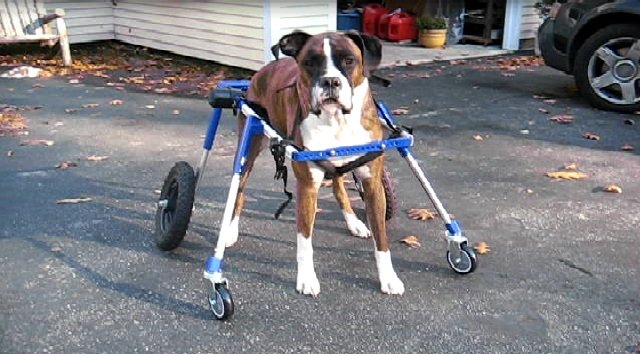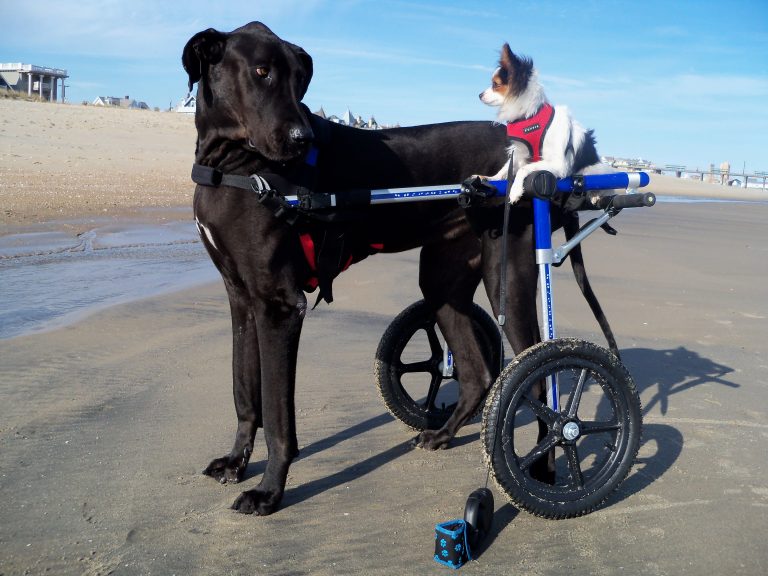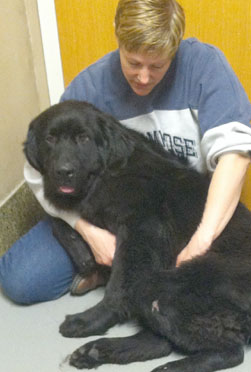Wheelchairs in Rehabilitation

Benefits and Patient Selection When Using a Quad Cart in Your Rehab Treatment Plan:
Patient selection is key to utilizing a quad cart to act as part of a rehab treatment plan. Geriatric patients that may be diagnosed with Polyneuropathy, Cervical/Thoracic/Lumbar Disk Disease, FCE, or just very weak in all four limbs due to age related changes in muscle strength, make good candidates for assistive intervention. A quad cart will keep the patient in a standing position, and promote an opportunity for the patient to walk with assistance. You may also use this in combination with proprioception training and gait patterning to improve recovery. It is definitely easier on a therapist to accomplish this without having to hold the patient up in a standing position at the same time. Especially when your patient is overweight and learning to walk again. A quad cart will allow more movement and encourage weight bearing earlier in patients with Tetraparesis.
How to Integrate Quad Cart Time in Your Workouts and At Home Programs:
Every therapist may design their appointment schedule and at home programs differently. So we’ll give you a few ideas, how you may choose to add in Quad Cart time as an exercise. Keep in mind, that the amount of weight supported by the cart can be adjusted. So you may start with more support, and slowly decrease the support the cart is providing as the patient progresses.
Assisted Walking Exercise: Place the patient in the quad cart, and encourage walking. It’s best to start off with short timed walks and increase the duration over time. The patient will fatigue quickly. Beginning with 1-2 minute walks with breaks in between may be a good starting point. No more than 6-10 minutes for the first cart walk.
Assisted Walking with Proprioception Training: Place the patient in the quad cart. For example, if the hind limbs have proprioceptive deficits, try placing a Theraband, Scrunchie, or TheraPaw Dorsi-Assist on the affected limb. Begin walking. This exercise will encourage proprioception training and may be increased at the therapist’s discretion.
Gait Training: There is an option to place locking rear hospital wheels on the Walkin’ Wheels Quad Cart. This will allow you to use the cart with your land treadmill. It may even fit with some Underwater Treadmills as well. This will allow the patient to be properly supported so patterning of limbs can be done. Once again, you can decrease the amount of support the cart is providing, but still save your back at the same time.

Assisted Walking with Strength Training: Once the patient has gotten stronger but still may need moderate support for workouts, you can add leg weights to any limb that needs increased strength. It may be best to only apply one leg weight at a time, but it’s up to the therapist’s discretion how much weight and how long is appropriate based on the patient.
Keeping a quad cart for hospital use, and then one or two for at home rentals is a good idea. You may add any of the exercises listed above to a patient’s at home program. The carts are easy to use, and most owners are very willing to learn. You may consider charging a rental fee per week for any carts you send home with owners. Whatever you think will work best for your practice. Adding these exercises when appropriate to at home programs, will allow the owner to see their beloved pet’s journey to recovery a bit more.
Benefits and Patient Selection of Using a Hind Limb Cart in Your Rehab Treatment Plan:
Patient selection is always the most important thing to successfully using carts in your rehab treatment plan. Pets that are recovering from surgeries such as: TPLO’s, TTA’s, Total Hip Replacements, FHO’s and many others, may benefit from cart assistance early in their recovery. We all know that improving patient comfort level, encouraging weight bearing, improving range of motion and increasing muscle mass, are on our goals to accomplish list. In certain cases, providing assistance with a hind limb cart early on, may promote this. It is definitely a case by case basis decision, but something else to think about. It may also prevent falling or slipping, which as we know can be harmful to surgery sites or implants as their healing. Once again keep in mind, the amount of support provided can be adjusted. Our goal is to encourage weight bearing early, not allow the patient to become dependent on the cart. Using this as part of a rehab plan for the first 2-4 weeks after surgery, may help to prevent injury to the non-affected hind limb by giving extra support verses increasing the amount of weight placed and possibly creating new injuries. Of course a patient that has a history or current injury in a forelimb, may not be a candidate for the cart.

You may choose to add leg weights, or create exercises to be done in the cart as part of a rehab treatment plan. Once the patient is stronger, further in recovery, or placing even weight on the affected limb, you may discontinue the cart and proceed with your rehab treatment plan. You may choose to keep a few in hospital, or rent to owner’s if their patient will benefit from it.
There are no set in stone guidelines for rehab. There are exercises, settings and things that a therapist prefers due to experience. We’re always looking for new ways to improve our patient’s outcomes during recovery. We have the option to be open-minded and creative when designing treatment plans. That’s one of the best things about our job!
Interesting Use of a Cart in Post Op Case
Follow Maddie’s story on the road to recovery!
4/9/13 – Maddie had an excellent session with Jocelyn this morning and she was joined by Julie who is also a Massage Therapist! She had double the attention and loved every minute of it! She also was fitted with a boot to work at getting her better traction on her left foot which seems to give her problems. It went extremely well, as did the climbing on the bench FIVE times!!! Whew! THAT was a lot of work but then Jocelyn had her hold herself there, with front feet on the floor and rear feet tucked up under her without tilting either direction. That took at lot of strength and was a great exercise.
